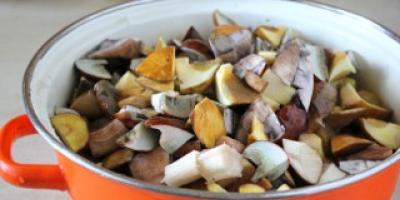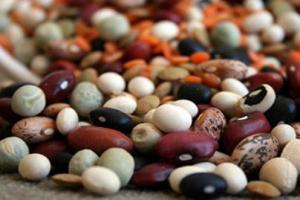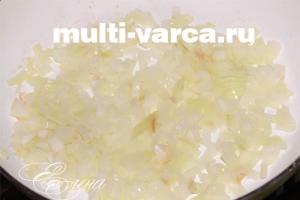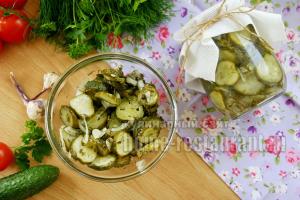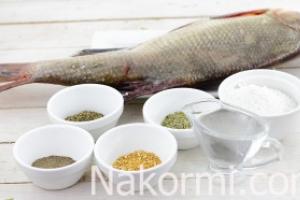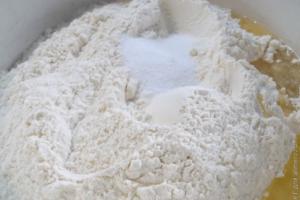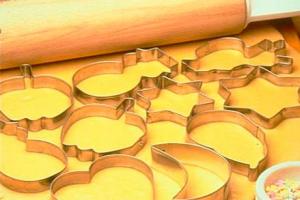Jellied beef legs - nutritious and healthy snack dish, which you need to be able to cook correctly. There are many recipes of this dish: It’s not difficult to make them at home, the main thing is to follow the preparation technology, and then the jelly will turn out transparent, tasty and rich.
Jellied meat made from beef legs is the most delicious. To ensure that the dish holds its shape well, it is recommended to choose the part of the legs that is located closer to the hoof. It is also important to take the knuckle - it is meat with veins and joints. You should not use the “clean” meat part, as it will not allow the dish to keep its shape.
Attention! Some people cook jellied meat from the tail, head or ribs, because they contain cartilage and veins - they make it possible to obtain a rich broth, which, after pouring into bowls, easily gels (in this case, you do not have to add gelatin to the recipe). If you take only the pulp, homemade jellied meat will not be able to completely harden.
To make jelly, you will need the following set of products:
- shank (this should be a joint with enough meat);
- beef leg;
- small knuckle - meat ingredients should weigh an average of 4 kilograms;
- 2 large onions;
- carrots (2 pieces);
- garlic – 8 cloves;
- bay leaf;
- a little black pepper (preferably peppercorns);
- water - on average you will need 4 liters;
- salt.
It is not difficult to prepare jellied meat from beef legs - it is done as follows:
- First, you need to choose the right beef - this will help you make a rich jellied meat that will hold its shape perfectly. Before cooking, the legs need to be chopped so that they fit into the pan. The correct ratio of beef and water is 1:1.
- Take a pan of suitable size, place the bones and fill with water. If the beef “components” are packed tightly, the water should only lightly cover them. As it boils, remove the foam and reduce the heat to low. It takes 4-5 hours to cook the bones.
- Carrots and onions can be put into the broth with their peels (rinse them well in advance), or you can peel the roots. Garlic is chopped as desired and added to the broth - this can be done while boiling the bones or added to the meat in ramekins.
- After 4-5 hours, add meat, spices, roots and salt to the bones. For this amount of broth you need to take one large spoon of salt. Now cook the jelly for another 2 hours on medium gas.
- We take out the onions, carrots and boiled meat from the jellied meat. We wait until it cools down, after which we cut the beef as desired. At the same time, you need to carefully feel it so that there are no small bones inside.
- Place the shredded beef in bowls or molds where the jelly will harden.
- Before pouring the broth, you need to strain it 2-3 times - ordinary gauze will help with this.
- Fill the chopped meat with broth - in total it should occupy 1/3 of the container.
- Place the bowls in the refrigerator and leave the jelly to harden.
You can serve beef leg jelly with mustard or horseradish, as they are considered a classic addition to the recipe.
Cooking in a slow cooker
It is not difficult to make jelly using modern kitchen appliances.



To prepare 15 servings you will need:
- liter of water;
- 1700 grams of beef shanks and the same number of legs;
- 100 grams of carrots;
- 100 grams of onion;
- a pinch of salt;
- favorite spices and herbs.
Method for preparing jelly using kitchen appliances:
- We soak the legs and shins well so that all excess blood is removed from them. As a result, the liquid must become transparent.
- When the main component is ready, prepare the roots - peel the onion and remove the tail, and remove the peel from the carrots and divide into 2 parts.
- Place all the ingredients in a pan, pour the required amount of water and salt. Close the lid of the multicooker, set the “Meat” mode and cook for an hour.
- After the time has passed, place the legs on a plate and strain the broth several times. Cool the meat slightly and cut into small pieces. Then put it in bowls and sprinkle with herbs and garlic.
- The last step is to pour the meat broth into the molds and put them in the refrigerator.
After hardening, the jelly can be brought to the table with any additives.
Cooking technology with gelatin
If the bones do not have enough gelling components, you can prepare jelly with gelatin.

Ingredients required to prepare the recipe:
- beef (it is better to choose the knee bone, where there will be a sufficient amount of meat);
- a pack of gelatin;
- one onion and one carrot each;
- cloves, garlic, salt;
- a couple of bay leaves.
How to make jelly with gelatin:
- We wash the beef and place it in a pan of suitable size, fill it with the required amount of water and place it on the stove. As the broth boils, keep it on the gas for 2 minutes, and then remove all the foam.
- Drain the water and fill the pan again with water, add spices and salt.
- We clean the roots and put them in a saucepan. These ingredients can give the jelly transparency.
- Cook the jellied meat until the beef is ready - eventually it should begin to peel off the bones. Once the meat is cooked, let it cool and cut into small pieces.
- Strain the broth several times and taste for salt. Pour half a glass of liquid and let it cool. Then pour gelatin into a glass and wait for it to swell.
- Boil the broth again and pour gelatin into it. We wait for it to boil, constantly stirring it with a spoon so that the gelatin can completely dissolve.
- Place the beef in the molds, then fill it with slightly cooled broth.
- The last step is chopping the garlic and putting it into bowls.
The jelly needs to harden in the refrigerator - this usually takes 3-5 hours. After this, the dish can be served with your favorite toppings.
Jellied beef legs in a pressure cooker
In order for the jelly to be elastic after cooking, you need to choose the right ingredients. In addition to beef, you can also use turkey, pork or chicken. It is advisable that all selected meat have skin on it – it helps the jellied meat to quickly harden.



Required components:
- legs – 700 grams;
- 1.5 kilograms of beef meat;
- one onion and one carrot each;
- salt and bay leaf.
The cooking process is as follows:
- First of all, soak the meat well - this usually takes 3-5 hours.
- We put it in a pressure cooker, and then pour in water (the liquid should completely cover the product - on average you need to take 2 liters of water).
- As the broth boils, drain it and fill the beef with clean water.
- Peel the onions and carrots, add them to the pressure cooker with the meat and wait until they boil.
- Add salt to the pressure cooker, set the device to the “Stew” mode and make the jelly for 45 minutes. It is important to close the steam valve.
- As you prepare, leave the jelly for 5-6 hours in a closed pressure cooker.
- We separate the meat into small pieces and put it in molds. Then pour the broth into them and add chopped garlic.
- two carrots;
- a pair of onions;
- pepper (peas or allspice);
- bay leaf and salt.
- To begin with, the legs need to be washed and then the hoof removed.
- Place them in a saucepan, add water and boil. Then drain the broth and add new water (this must be done so that the jelly is transparent).
- Cook the meat for 6-8 hours, sometimes skimming off the foam. An hour before the end of cooking, add onions and carrots to the broth. And 30 minutes before the end of cooking, add spices and salt.
- As soon as the meat is cooked, take it out, cool and cut it. Then strain the broth using gauze.
- Place the pork and beef in small ramekins, pour in the broth and sprinkle with chopped garlic.
Cooking method:
Once the jelly has hardened, it can be served with your favorite toppings.
1. You need to start preparing jellied meat two to three days before the expected date of its serving. First you need to soak the meat. Place it in a large saucepan or bowl and pour cold water. For five hours, constantly drain the water and replace it with new, clean water. After this time, place the meat and bones in the pan in which you will cook the jellied meat, and fill everything with cold water. It is very important to maintain the proportions, so the meat should be packed quite tightly, and you need to pour enough water so that it is more than five centimeters above the meat. During the cooking process, do not add water, as the jellied meat will not harden well.
 2.Now your jellied meat will cook. Please be patient right away, as this will take a long time. Bring the water to a boil over high heat and skim off the foam. Don’t miss the moment, as the transparency of the broth depends on it. If you wish, after boiling, you can drain the broth and refill with clean cold water. Wait until it boils again and only then reduce the heat to medium. At this stage, the broth needs to be salted. Calculate salt based on the fact that it is barely noticeable in frozen jellied meat, so you need more of it than usual. But if you are afraid of oversalting, then add a little, and at the end add salt to taste. Now cover the pan loosely with a lid (leave a gap of one centimeter) and cook for three hours.
2.Now your jellied meat will cook. Please be patient right away, as this will take a long time. Bring the water to a boil over high heat and skim off the foam. Don’t miss the moment, as the transparency of the broth depends on it. If you wish, after boiling, you can drain the broth and refill with clean cold water. Wait until it boils again and only then reduce the heat to medium. At this stage, the broth needs to be salted. Calculate salt based on the fact that it is barely noticeable in frozen jellied meat, so you need more of it than usual. But if you are afraid of oversalting, then add a little, and at the end add salt to taste. Now cover the pan loosely with a lid (leave a gap of one centimeter) and cook for three hours.
 3.After the specified time, add peppercorns and bay leaves into the broth and leave the jellied meat to cook for another hour. Prepare the onions and carrots - the latter needs to be peeled (leave the onions in the peel), and then make small cuts on them (this will allow the vegetables to release their juice better). After an hour, throw them into the broth without cutting them.
3.After the specified time, add peppercorns and bay leaves into the broth and leave the jellied meat to cook for another hour. Prepare the onions and carrots - the latter needs to be peeled (leave the onions in the peel), and then make small cuts on them (this will allow the vegetables to release their juice better). After an hour, throw them into the broth without cutting them.
 4.Look at your jellied meat after another hour and a half. Some of the water should already boil away and the bones should move away from the meat. If there are bones that have completely fallen off the meat (bare), then remove them and discard them.
4.Look at your jellied meat after another hour and a half. Some of the water should already boil away and the bones should move away from the meat. If there are bones that have completely fallen off the meat (bare), then remove them and discard them.
 5. The jellied meat will be ready after six to seven hours of cooking. A signal that it can be removed will be the bones coming away easily from the meat, less water than at the beginning, and the rich color of the broth. Then you can remove the bay leaf and onion and discard them. Remove the carrots, but do not throw them away. Taste the broth for salt – it should taste good. If it’s still not enough, add more salt. Peel the garlic and pass it through a press, and then add it to the jellied meat. Let everything simmer for a minute and turn off the heat.
5. The jellied meat will be ready after six to seven hours of cooking. A signal that it can be removed will be the bones coming away easily from the meat, less water than at the beginning, and the rich color of the broth. Then you can remove the bay leaf and onion and discard them. Remove the carrots, but do not throw them away. Taste the broth for salt – it should taste good. If it’s still not enough, add more salt. Peel the garlic and pass it through a press, and then add it to the jellied meat. Let everything simmer for a minute and turn off the heat.
 6. Remove the bones and meat from the hot broth. You can immediately throw away the bare bones - we no longer need them.
6. Remove the bones and meat from the hot broth. You can immediately throw away the bare bones - we no longer need them.
 7.Next, take a sieve and another saucepan. You will also need a piece of gauze, folded in half. It needs to be placed on a sieve. Strain the broth until it is clear (you will still have peppercorns, small seeds, and garlic on the gauze).
7.Next, take a sieve and another saucepan. You will also need a piece of gauze, folded in half. It needs to be placed on a sieve. Strain the broth until it is clear (you will still have peppercorns, small seeds, and garlic on the gauze).
 8.Now place the meat on deep plates in which you will serve the jellied meat. For beauty, you can cut the boiled carrots into slices and put a few pieces on plates. When laying out the meat, remove everything that you do not eat (skins, fat, films, remaining bones). If you come across large pieces of meat, disassemble them into small fibers.
8.Now place the meat on deep plates in which you will serve the jellied meat. For beauty, you can cut the boiled carrots into slices and put a few pieces on plates. When laying out the meat, remove everything that you do not eat (skins, fat, films, remaining bones). If you come across large pieces of meat, disassemble them into small fibers.
 9. It remains to fill the jellied meat with strained broth. Wait until it cools completely and put it in the refrigerator. There is no need to put it in the freezer to harden; if it is cooked correctly, then in the cool it will begin to harden on its own. When the jellied meat has hardened, you can optionally remove a fatty film from the surface, if any has formed.
9. It remains to fill the jellied meat with strained broth. Wait until it cools completely and put it in the refrigerator. There is no need to put it in the freezer to harden; if it is cooked correctly, then in the cool it will begin to harden on its own. When the jellied meat has hardened, you can optionally remove a fatty film from the surface, if any has formed.
 Delicious jellied meat is ready. Before serving, you can flip it flat and you will end up with a jelly mound. Decorate it with a sprig of greenery and place it on the table. Horseradish or mustard goes very well with this dish, so don’t forget to put it on the table. Bon appetit!
Delicious jellied meat is ready. Before serving, you can flip it flat and you will end up with a jelly mound. Decorate it with a sprig of greenery and place it on the table. Horseradish or mustard goes very well with this dish, so don’t forget to put it on the table. Bon appetit!
The classic recipe for jellied meat goes back to ancient times. So deep that today no one can name the exact year or even century. There is a widespread legend of its origin: someone cooked a strong broth, poured it over the meat, and left one plate in the cold. This is how the world's first jellied meat turned out.
Indeed, this dish is very simple, even unpretentious. But at the same time, it’s festive. This is how interesting psychology works. A tureen of borscht is unlikely to end up on the table on New Year's Eve. And there will certainly be jellied meat. Although, if you think about it, jelly and soup are all meat broth with pieces of fillet. Only the jellied meat froze. This means you can “play” with it – serve it beautifully, and even pour it into a beautiful mold so that it turns out both tasty and beautiful.
The classic recipe for making jelly is based on long cooking pork feet, without the use of gelatin. In this part pork meat there is enough collagen for the broth to solidify and acquire the desired consistency. But can the same thing be repeated with beef? Of course you can, but only if you know some nuances.
So, let's look at the beef jellied recipe step by step with photos and comments. First, let's try the version without gelatin. Don't worry - the jelly will certainly harden. But there is one condition - you need to choose the right meat. More precisely, the right cut of beef. If in the case of pork we were talking about legs, then for beef jellied meat we will take the same part - i.e. shin.
We take the following components:
- beef shin - 2 kilograms;
- veal fillet – 1 kg;
- carrots and onions – 1 piece each;
- garlic – 3 cloves;
- salt, bay leaf and pepper - to your taste.
Jellied meat is a frozen broth, so we will definitely pay the main attention to cooking our soup.
The classic recipe for beef jellied meat looks like this step by step:
- First we prepare all the products. We will work especially carefully with meat. It is better to rinse the beef shin well under running water, and then chop it into pieces, and then rinse again.
- Place the leg and fillet in a pan with cold water. The water should completely cover the meat, and the level will be 2-3 fingers higher. Cook until boiling (over high heat). As soon as it begins to boil, immediately reduce it to moderate. We remove all the foam.
- Now comes the crucial stage. Over the next 4 hours, our broth will cook at a low simmer. The water shouldn’t boil at all – just fluctuate a little and produce weak bubbles. Keep the lid tightly closed, otherwise the water will evaporate too much. But adding a new one is undesirable - the taste of the broth inevitably deteriorates, and besides, it darkens.
- Meanwhile, peel the onions and carrots. When 4 hours have passed, put them in the pan. And also bay leaf, salt and pepper. We do everything according to our taste. It’s just important to take into account that we add salt at the end, not at the beginning. Otherwise, you can over-salt - after all, the water will evaporate a little anyway.
- An hour after adding the vegetables, turn off the stove. Cut the meat, remove the bones and onions and carrots. We pass the meat through a meat grinder or cut it into small pieces using a knife. Place the resulting minced meat on the bottom, and then vegetables for decoration. Pour broth on top. You can lay it out either in another pan or in special shaped molds - this way the dish will look especially beautiful.
- And immediately after turning off the heat, don’t forget to add finely chopped garlic - it will give the appetizer a fragrant aroma.
- This completes the beef jellied recipe. All you have to do is wait until everything cools down (in the refrigerator or on the balcony), and this will take many hours. But the result is worth it! Serve with mustard and herbs (appetizing option in the photo).
ADVICE
After preparing the broth, it would be nice if we strained it. To do this, use a large sieve and another pan.

Option with gelatin
But what if the recipe for beef legs cannot be reproduced step by step, and the photos do not help? After all, beef shins may simply not be on hand. Of course, this is not a reason to refuse delicious food. holiday snack. Here gelatin will come to our aid - it is completely harmless. food additive, which does not affect the taste in any way. And gelatin will certainly create the desired consistency!
This time we will need the following products:
- beef fillet – 700 g;
- gelatin – 50 g (2 sachets);
- carrots and onions - 1 large piece each;
- 4 cloves of garlic;
- salt, bay leaf and pepper - at your discretion.
In this case, we are essentially reproducing classic recipe jelly step by step, which is described above. However there will be one change:
- The recipe for beef jellied meat begins, as usual, with cooking the broth. Place the fillet in a saucepan, bring to a boil, remove the foam and place on low heat.
- All this time we carefully monitor that excess liquid does not evaporate. And besides, we constantly remove the foam - it will probably still stand out.
- When 4 hours have passed since boiling, add onions, carrots and spices. We wait another hour. Add finely chopped garlic to the broth.
- And now the important stage begins. We dilute gelatin in hot water and let it swell a little. And pour it into the broth. Let it cook for literally 5 minutes. Turn off the stove, grind the meat in a meat grinder and place it on the bottom of the mold.
- Well, then as usual - pour the broth, decorate with carrots and other vegetables (as your imagination dictates).
- You can cut the beef jelly into beautiful slices and serve with pickles and garnish with a sprig of rosemary (see photo below).
The festive jellied meat will be ready in a few hours. So it's better to start preparing in advance.

What Russian doesn't like jellied meat? With horseradish, mustard, vinegar, or just a bite of garlic. Jellied meat is prepared from any meat: pork, beef, chicken. The most delicious is the so-called “combined” one - from several types of meat. But today we will tell you how to cook beef jellied meat.
When cooking any jellied meat, remember the following proportion: put such an amount of meat products into the pan so that it is half meat, and half bones and cartilage. It is from the latter that the broth is obtained, which ensures the hardening of the jellied meat. But it's not enough to buy regular beef bones and mix them with tenderloin. Those parts of the carcass where there is a lot of connective cartilage are best suited for jellied meat. The best raw materials for jellied meat are considered to be beef shank (part of the leg with a joint) and beef tail. Wash the shank well, and if it fits completely into the pan, you don’t even have to cut it. Chop the tail into pieces and wash it too. Visually determine the proportions of meat and bones by eye. If you think there are more bones, add another piece of meat. Fold meat products into a large saucepan - a five-liter saucepan is quite suitable for 3 kg of prepared ingredients. Pour cold water over the meat so that it completely covers it and there is another 2-3 fingers on top.













A little advice. If you cook a lot of jellied meat and are going to give it to relatives or friends, then make some of it in jars. Jars with a volume of 0.5-0.75 liters are best suited for these purposes. Cover the frozen jellied meat with nylon lids and do not be afraid that it will turn over or leak during transportation.
Step 1: prepare the meat.
To prepare jellied meat, the meat must be on the bone. Rinse the beef and ribs well under warm running water. Then we transfer it to a cutting board and, using a kitchen knife, thoroughly clean it of the chaff and veins.Step 2: prepare the onion.

Using a kitchen knife, peel the onions and rinse well under running water. Then transfer the whole peeled vegetable to an empty plate.
Step 3: prepare the carrots.

Peel the carrots using a kitchen knife and then rinse under running water. Afterwards, transfer the carrots to a cutting board and, using a kitchen knife, cut the vegetable lengthwise a 4 parts. Then transfer to a plate with onions.
Step 4: prepare the garlic.

Place the garlic cloves on a cutting board and, pressing on them with the handle of a knife, remove the husks. Then, using a garlic press, chop the vegetable and transfer it to a separate plate. Attention: The garlic can be finely chopped using a kitchen knife.
Step 5: Prepare the parsley root.

In order for the meat broth to acquire an aromatic smell, you need to add parsley root to it. Using a kitchen knife, thoroughly remove the skin and then rinse well under warm running water. Attention: It is best to use fresh parsley root.
Step 6: prepare the broth.

Place the beef and ribs into a saucepan and fill with cold water until the liquid completely covers the meat. Place the container on high heat and bring to a boil, cook for 10-15 minutes. Then, using oven mitts, remove the container from the heat and drain all the liquid into the sink. Remove the meat from the pan and rinse thoroughly again under running water. We also rinse the container well under water.
Then put the washed beef into the same bowl and fill it with clean cold water. Attention: The container in which the broth will be cooked must be taken so that the meat can cook freely in it and is not pressed to the bottom or walls. Otherwise, the beef may burn. Again, over high heat, bring the liquid to a boil, and then turn the heat to very low.
After boiling, remove foam from the surface of the broth until it stops forming. Salt and add parsley root. It is very important that the fire maintains a very small, barely noticeable boil, then the broth will be transparent, and accordingly the jellied meat will not be cloudy. Cover the pan with a lid, leaving a small crack for steam to escape, and cook the broth for 3-4 hours. During this time, using a tablespoon, periodically stir the meat in the broth. Attention: if you cover the pan with a lid with a special hole for steam to escape, then the lid does not need to be opened slightly.

After this time, lay out the onions and carrots and continue to cook our future jellied meat for another 2-3 hours. It is very important not to add more water to the broth, as in this case the jellied meat may not completely freeze. Before finishing cooking the broth, add bay leaf and black peppercorns to the pan. When the broth is ready, turn off the burner and set the pan aside.
Holding the container with an oven mitt, use a slotted spoon to remove the meat, parsley root, bay leaf and vegetables from the broth. When the broth has cooled slightly, strain it through a sieve into an empty pan. Meat bones, chaff from ribs and allspice peas can be discarded.
Step 7: prepare boiled meat for jellied meat.

Place the finished, cooled meat on a flat plate and separate it from the bones and chaff by hand or using a kitchen knife or fork. Then cut into small pieces of equal size and transfer them to a free bowl. Although usually in traditional dish the meat is separated into fibers. In this case, it is desirable that the width of the meat fibers be no more than 0.5 centimeters, and the length – near 3-4 centimeters. If the fibers are long enough, then they need to be cut crosswise into shorter ones, since long meat “strings” in jellied meat are inconvenient to eat.
Step 8: prepare beef jellied meat.

Transfer the meat pieces into a glass tray. Sprinkle it with chopped garlic on top, and then, using a ladle, fill it with cooled meat broth. If desired, the jellied meat can be decorated with slices of boiled carrots or even cut out into figures. Cover the container with a lid, cool to room temperature, and then place the tray in the refrigerator to harden.
Through 3-4 hours the jellied meat will be ready. Attention: if you want to pour the jellied meat into smaller containers: bowls or plates, then before you put the meat in these containers, you need to calculate the volume of the resulting broth so that each container contains approximately the same amount of liquid. We also visually divide the meat into equal portions. Cover the bowls on top cling film or food foil and place in the refrigerator.
Step 9: Serve the beef jellied meat.

Take the finished frozen beef jellied meat out of the refrigerator, cut into portions and serve on the festive table. Separately in a saucer you can put horseradish, mustard or vinegar, whatever you like.
Bon appetit!
To prepare jellied meat, you must definitely use meat with bones, cartilage and joints. It is these components that give the jellied meat the opportunity to harden. The proportion of meat and bones in the broth should be 1:1.
For cooking delicious jellied meat You can take just one meat or assorted meats.
If the jellied meat does not freeze, it means that you have made a mistake in the proportions of meat and liquid. Then you will have to add gelatin to the broth so that your dish hardens. But then the jellied meat will be called, rather, jelly or meat aspic.
The transparency of the jellied meat depends on the intensity of the boiling of the broth: the hotter it boils, the cloudier the jellied meat will be. Therefore, cook the broth for jellied meat over very low heat.
If you add to jellied meat raw garlic, that is, not while cooking the broth, then the shelf life of your dish may be limited to 3-4 days. Do not eat sour jellied meat; you may get food poisoning.
